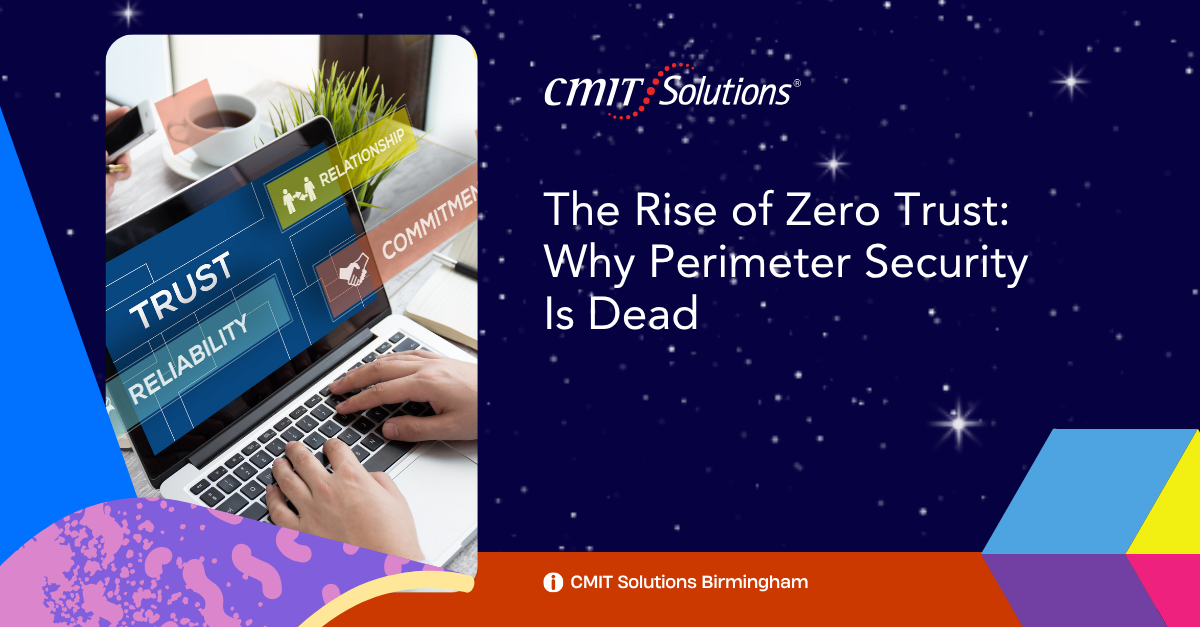For decades, businesses operated under a simple cybersecurity principle: keep the bad actors out and trust everything inside the network. This model, often referred to as perimeter security, relied on firewalls, antivirus software, and centralized monitoring to guard against external threats. But today, the perimeter is gone.
In the era of remote work, cloud computing, and mobile-first collaboration, the traditional network boundary has dissolved. Employees work from anywhere, data lives in multiple places, and threat actors have grown more sophisticated. The answer isn’t reinforcing a crumbling wall—it’s adopting Zero Trust.
Zero Trust security assumes one crucial truth: never trust, always verify. It means every user, device, and application must prove its identity and be continuously validated—whether inside or outside your network. Let’s explore why Zero Trust is now a necessity, not a luxury.
From Castle-and-Moat to Cloud-and-Mobile
The old cybersecurity model worked when data and users were centralized. A firewall protected the “castle,” and everyone inside the moat was considered safe. But businesses don’t operate in castles anymore—they operate in the cloud, across time zones, using software-as-a-service platforms and personal devices.
As a result, the traditional model breaks down in several ways:
- A remote employee’s personal device may lack proper encryption.
- Cloud-stored documents may be accessed without VPNs or monitoring.
- Attackers who breach one endpoint often gain lateral access to the entire system.
This is exactly why businesses in Birmingham are turning toward hybrid cloud strategies that integrate secure infrastructure with mobile flexibility. But the hybrid model only works when it’s built on a foundation of Zero Trust.
What Is Zero Trust? (And What It’s Not)
Zero Trust isn’t a product—it’s a philosophy. It requires that:
- No device or user is trusted by default.
- Access is granted based on identity, device posture, and behavior.
- Policies are enforced in real time, continuously.
It’s not just multi-factor authentication or endpoint security. It’s a holistic shift that redefines how businesses think about digital trust.
For Birmingham SMBs, this means transforming not just tools, but also IT processes. Whether it’s smart productivity platforms or secure collaboration software, Zero Trust embeds security into everything—not just the firewall.
Why Perimeter Security Fails in Today’s Threat Landscape
Attackers no longer break in—they log in. Phishing, credential stuffing, and token theft are now among the most successful forms of cyberattack. Once inside the perimeter, they move freely.
The explosion of remote work has only amplified this weakness. Without Zero Trust, businesses face threats such as:
- Compromised user accounts accessing sensitive systems undetected
- Employees connecting from unsecured networks or outdated devices
- Insider threats or misconfigured permissions exposing critical data
The best defense is assuming breach. That’s the core of the Zero Trust security model now adopted by leading businesses.
A Layered Approach: Key Principles of Zero Trust
Implementing Zero Trust doesn’t mean starting from scratch—it means building layers of intelligent validation around your users, devices, and data.
Some of the pillars include:
- User identity verification: Multi-factor authentication, role-based access
- Device posture monitoring: Ensuring every device is patched and compliant
- Least privilege access: Only give access to what’s absolutely necessary
- Microsegmentation: Isolate systems to limit lateral movement
- Continuous monitoring: Real-time analytics and anomaly detection
Next-gen network management tools enable these principles by allowing IT teams to control access dynamically and respond faster when behavior deviates from the norm.
Zero Trust Supports Modern Compliance
As regulatory demands rise, Zero Trust isn’t just good security—it’s good business. From HIPAA to GDPR to CMMC, compliance standards now emphasize data protection across distributed environments.
With remote work here to stay, compliance teams need visibility across endpoints, users, and access points. Zero Trust provides this by centralizing authentication, logging, and enforcement—without limiting flexibility.
Organizations using automated IT governance frameworks are already experiencing reduced audit stress and greater confidence in data protection protocols.
Zero Trust Is More Than Just a Cybersecurity Upgrade
What makes Zero Trust especially powerful is its strategic value. It aligns IT with broader business goals:
- It reduces risk while enabling innovation.
- It supports remote teams without sacrificing protection.
- It improves customer trust by securing digital interactions.
In short, Zero Trust supports business continuity, resilience, and long-term competitiveness. That’s why it’s becoming a cornerstone of modern IT strategy in Birmingham’s SMB market.
How to Start Implementing Zero Trust (Without Overhauling Everything)
For many SMBs, the idea of a “security transformation” sounds expensive and disruptive. But Zero Trust can be adopted in stages. Start by assessing your current security stack and identifying gaps. Then:
- Apply MFA across all users and platforms.
- Audit data access and remove excess permissions.
- Deploy endpoint detection and response (EDR) solutions.
- Monitor login patterns and flag suspicious activity.
Businesses working with tailored MSP packages find this journey easier—they gain access to expert guidance, customized tools, and 24/7 monitoring without the overhead of in-house teams.
The Power of Real-Time Detection and Response
Zero Trust works best when it’s backed by real-time insights. This is where AI-driven tools shine. From anomaly detection to automated patching, intelligent platforms can react instantly to unusual behavior—before it becomes a breach.
For example, an EDR platform might spot a user accessing a system at an odd hour from an unrecognized device. Zero Trust systems would immediately flag, block, or require re-authentication. This rapid response is especially valuable in hybrid environments, where employees work from home, office, or public networks.
That’s why modern data backup strategies now integrate real-time protection features that anticipate—not just recover from—disruption.
Communication Security in a Zero Trust World
It’s not just systems and files that need protection—your communication channels do, too. With phishing attacks now mimicking legitimate messaging platforms, even your Teams, Zoom, and email threads are at risk.
Unified communications platforms designed with Zero Trust principles offer secure login, message encryption, and real-time threat detection.
In high-risk industries like legal, healthcare, and finance, this level of communication security is becoming standard—and essential.
Conclusion: Don’t Reinforce the Perimeter—Rethink It
The cybersecurity battlefield has changed. Defending the perimeter is no longer sufficient—especially when the perimeter doesn’t exist. Devices, users, and data are everywhere. The only viable defense is to assume nothing and verify everything.
For Birmingham-based SMBs, this shift offers more than protection—it offers opportunity. Businesses adopting Zero Trust aren’t just securing themselves against ransomware or insider threats—they’re building confidence among clients, partners, and regulators.
And for leaders like Kerry Wheeles of CMIT Solutions of Birmingham South, the move to Zero Trust isn’t a reaction—it’s a long-term strategy to build cyber-resilient companies.
Stay ahead of what’s next in cybersecurity and IT by reviewing top trends shaping Birmingham’s business tech landscape.







